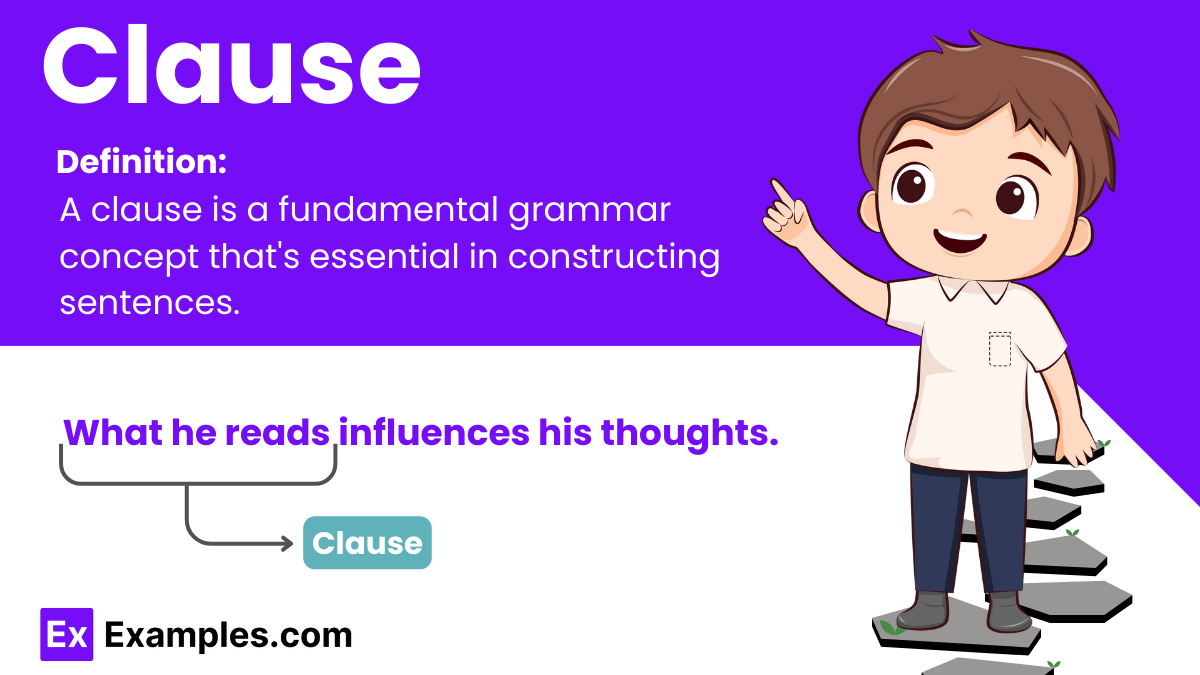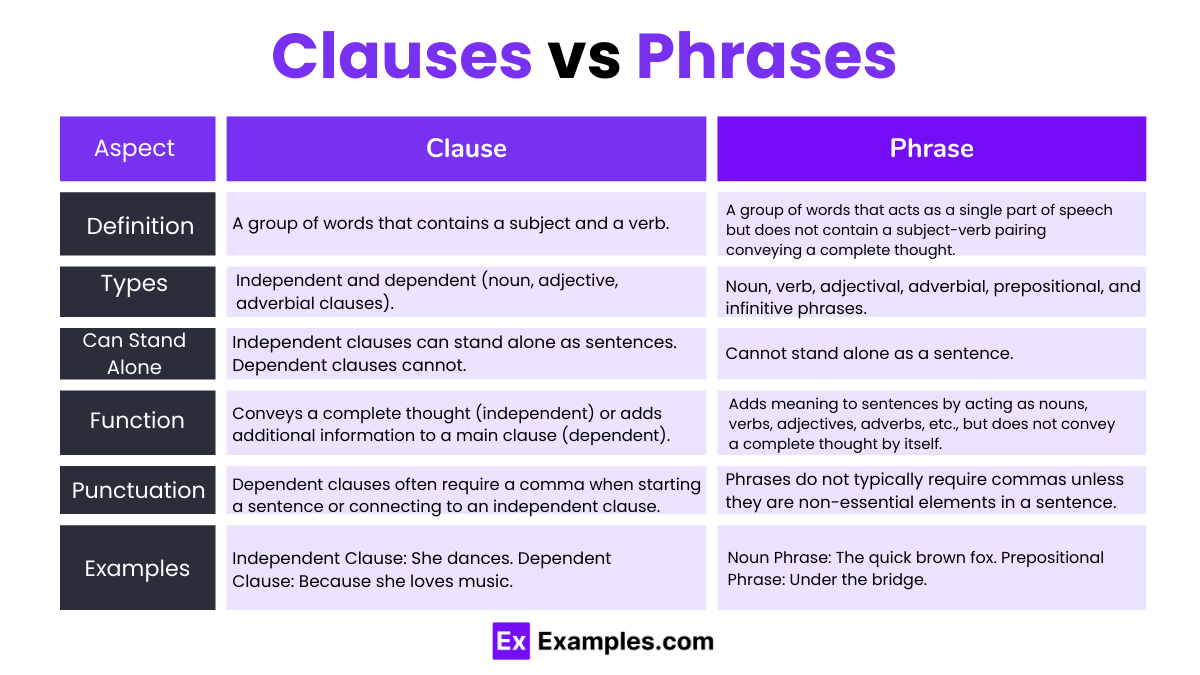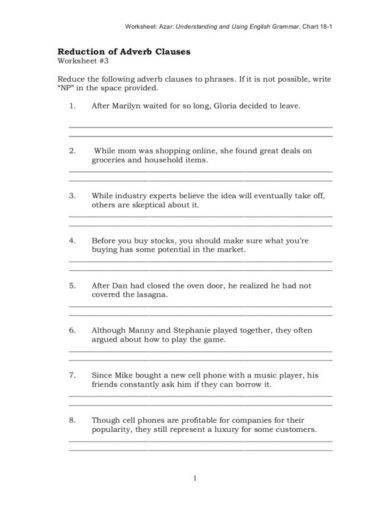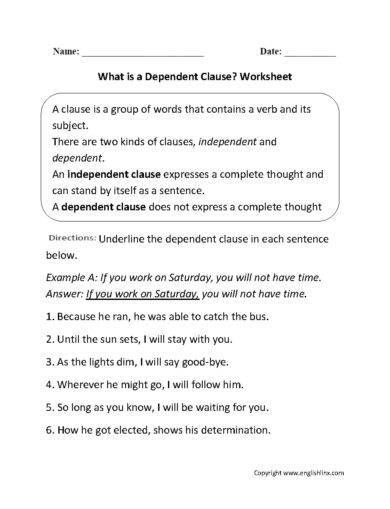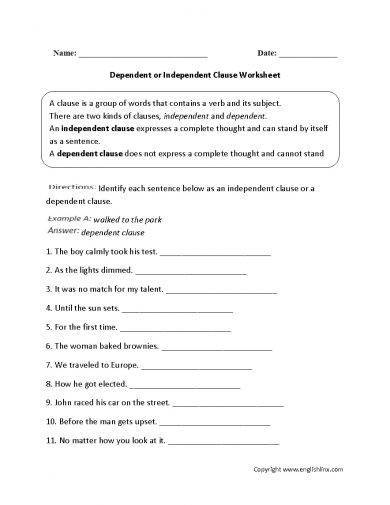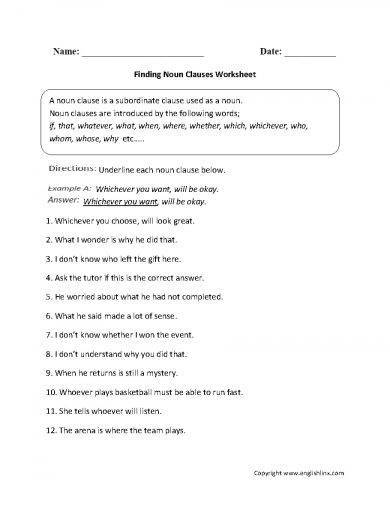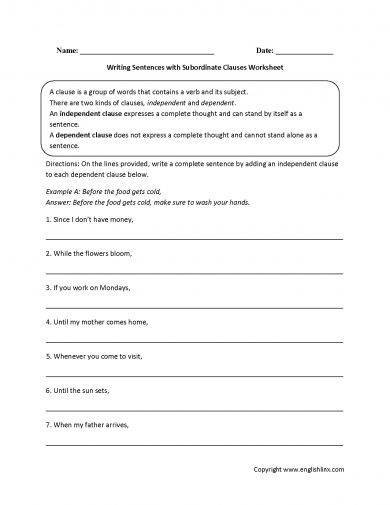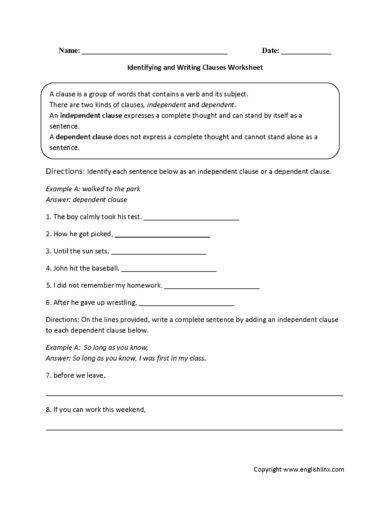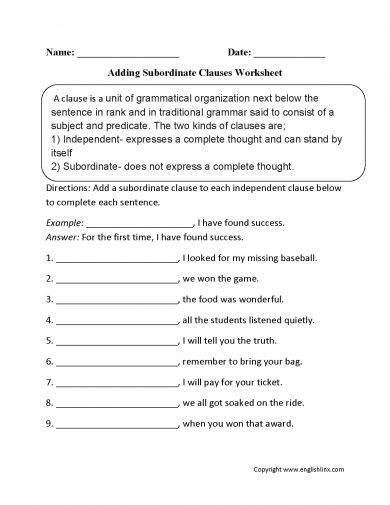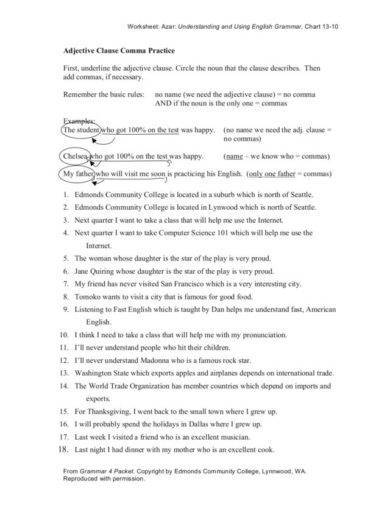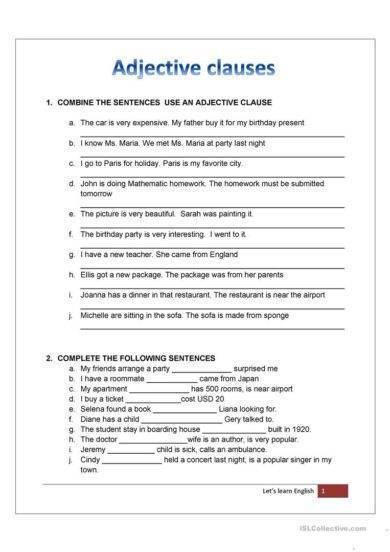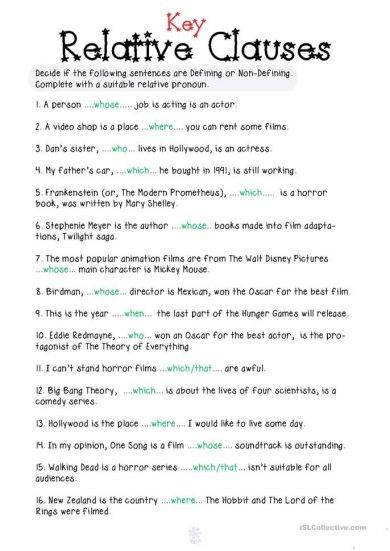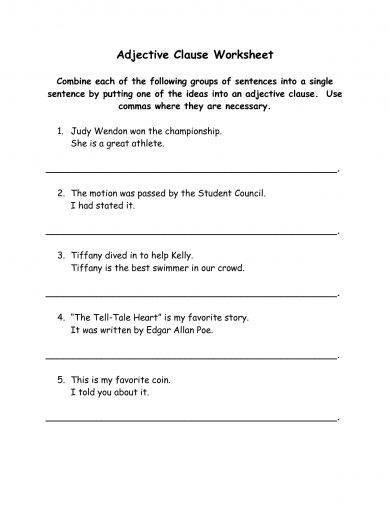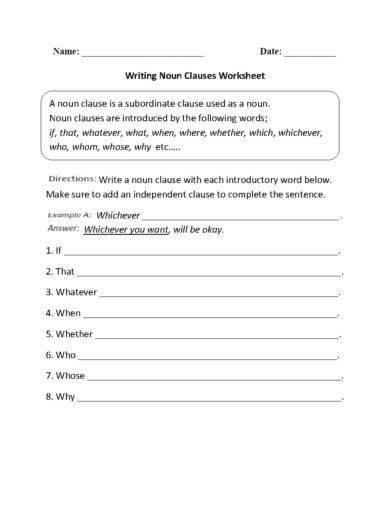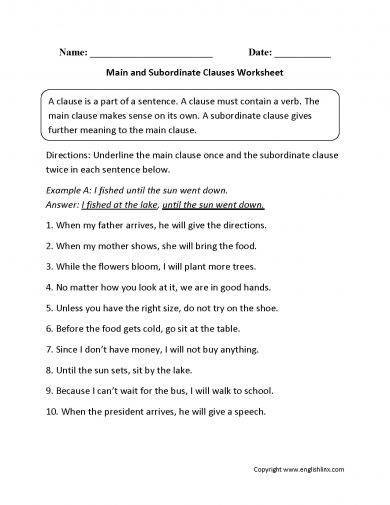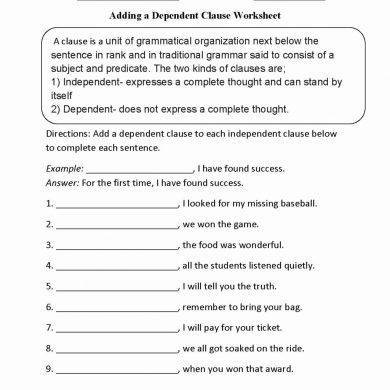30+ Clause Examples
The English language is a finite system that can be manipulated in infinite ways. Anyone who marvels at the thought of exploring the language will greatly benefit from understanding grammar clauses. This can be particularly helpful for students, instructors, and professionals across various fields who hope to improve their formal writing and reading comprehension for better communication.
What is a Clause?
A clause is a fundamental grammar concept that’s essential in constructing sentences. At its core, a clause is a group of words that contains a subject and a predicate (verb). Clauses are the building blocks of sentences and are categorized mainly into two types: independent (main clauses) and dependent (subordinate clauses).
Types of Clauses
Clauses are the backbone of sentences in the English language, providing structure and meaning by grouping words together. They are primarily categorized into two broad types: independent clauses and dependent clauses. Each of these categories branches out into more specific types, each with its unique role in sentence construction.
Independent Clauses
An independent clause is a group of words that contains a subject and a predicate. It expresses a complete thought and can stand alone as a sentence.
Example:
- The cat sleeps on the sofa.
Dependent Clauses
Dependent clauses, unlike independent ones, cannot stand alone as a sentence because they do not express a complete thought. They must be connected to an independent clause. Dependent clauses are further divided into three types based on their function within a sentence: noun clauses, adjective clauses, and adverbial clauses.
1. Noun Clauses
A noun clause functions as a noun within a sentence. It can serve as the subject, object, or complement.
Example:
- Subject: What she said was surprising.
- Object: I believe that he is honest.
- Complement: The truth is that he was late.
2. Adjective Clauses
An adjective clause describes or provides more information about a noun. It usually starts with a relative pronoun (who, whom, whose, that, which) or a relative adverb (when, where, why).
Example:
- The book, which is on the table, is mine.
- The man who called yesterday is my uncle.
3. Adverbial Clauses
Adverbial clauses function as adverbs, modifying a verb, an adjective, or another adverb. They indicate time, place, condition, contrast, cause, effect, and other relationships. These clauses typically begin with subordinating conjunctions such as because, if, when, although, since, until, and unless.
Example:
- Time: When the bell rings, we will go home.
- Condition: If it rains, we will stay indoors.
- Contrast: Although he is old, he is very active.
- Cause and Effect: Because it was raining, the match was postponed.
Combining Clauses
Understanding the different types of clauses is crucial for constructing meaningful and varied sentences. By combining independent and dependent clauses in various ways, writers can express complex ideas and maintain the reader’s interest through diverse sentence structures
Key Points about Clauses
Clauses are the building blocks of sentences in English, and understanding their structure and function is essential for effective communication. Here are some key points about clauses:
Definition and Structure
- A clause is a group of words that contains a subject and a predicate (verb). The subject is what or whom the sentence is about, while the predicate tells something about the subject.
Main Types
- Independent Clauses: These can stand alone as a sentence because they express a complete thought.
- Dependent Clauses: These cannot stand alone as they do not express a complete thought. They must be attached to an independent clause.
Functions of Dependent Clauses
Dependent clauses can function as:
- Noun Clauses: Acting as a subject, object, or complement in a sentence.
- Adjective Clauses: Providing additional information about a noun or pronoun.
- Adverbial Clauses: Modifying verbs, adjectives, and other adverbs by indicating time, place, reason, condition, etc.
Importance in Sentence Structure
- The way clauses are combined determines the complexity of the sentence structure. Simple sentences have one independent clause, compound sentences have two or more independent clauses, complex sentences have one independent clause and at least one dependent clause, and compound-complex sentences combine multiple independent clauses with one or more dependent clauses.
Punctuation
- Proper punctuation is crucial when combining clauses. Commas, semicolons, and conjunctions play key roles in indicating the relationship between clauses and ensuring clarity.
Variety in Writing
- Using a mix of different types of clauses can enhance writing by adding variety and complexity to sentence structures, making the text more engaging and expressive.
Understanding Relationships
- Clauses can establish various types of relationships within sentences, such as contrast (using “although”), cause and effect (using “because”), and condition (using “if”). Recognizing these relationships helps in both comprehension and effective writing.
Practice and Application
- Regular practice in identifying and using different types of clauses can significantly improve one’s writing and speaking skills in English. Exercises that involve combining sentences, identifying clause types, and rewriting sentences to change their structure are particularly beneficial.
How to combine Clauses
Combining clauses is a fundamental skill in writing, allowing you to express complex ideas with clarity and variation. Here are strategies to effectively combine independent and dependent clauses, enhancing your sentence structures.
1. Using Conjunctions
- Coordinating Conjunctions: Connect two independent clauses. Remember the acronym FANBOYS (for, and, nor, but, or, yet, so) to recall these conjunctions.
- Example: She enjoys reading, and she loves writing stories.
- Subordinating Conjunctions: Join independent clauses with dependent clauses, indicating relationships like cause and effect, time, and condition.
- Example: I will call you when I arrive home.
2. Using Semicolons
- A semicolon can link two closely related independent clauses. This method emphasizes the relationship between the two clauses without using a conjunction.
- Example: He loves to travel; he visits a new country every year.
3. Using Colons
- Use a colon to emphasize the second independent clause when it explains or illustrates the first clause.
- Example: She has one goal for this year: to learn a new language.
4. Incorporating Relative Pronouns
- Adjective Clauses: Begin with relative pronouns like who, whom, whose, which, and that. They modify nouns and pronouns in the main clause.
- Example: The book that you recommended was excellent.
5. Utilizing Relative Adverbs
- Adverbial Clauses: Start with relative adverbs like when, where, and why. They describe the verb in the main clause by providing details about time, place, or reason.
- Example: We went to the park where we first met.
6. Employing Conjunctive Adverbs
- Conjunctive adverbs (e.g., however, therefore, moreover) can also connect clauses. They often require a semicolon before and a comma after the conjunctive adverb.
- Example: The weather was bad; however, we decided to go hiking.
7. Using Commas
- When starting a sentence with a dependent clause, use a comma after it before introducing the independent clause.
- Example: Although it was raining, we went for a walk.
Tips for Effective Clause Combination
- Balance: Use a variety of methods to combine clauses for a more dynamic and interesting writing style.
- Punctuation: Pay attention to punctuation rules when combining clauses to ensure clarity and grammaticality.
- Relevance: Make sure the clauses you combine are related in meaning to maintain coherence in your writing.
- Practice: Regular practice with different structures will enhance your ability to combine clauses effectively.
Clauses vs Phrases
| Aspect | Clause | Phrase |
|---|---|---|
| Definition | A group of words that contains a subject and a verb. | A group of words that acts as a single part of speech but does not contain a subject-verb pairing conveying a complete thought. |
| Types | Independent and dependent (noun, adjective, adverbial clauses). | Noun, verb, adjectival, adverbial, prepositional, and infinitive phrases. |
| Can Stand Alone | Independent clauses can stand alone as sentences. Dependent clauses cannot. | Cannot stand alone as a sentence. |
| Function | Conveys a complete thought (independent) or adds additional information to a main clause (dependent). | Adds meaning to sentences by acting as nouns, verbs, adjectives, adverbs, etc., but does not convey a complete thought by itself. |
| Examples | Independent Clause: She dances. Dependent Clause: Because she loves music. | Noun Phrase: The quick brown fox. Prepositional Phrase: Under the bridge. |
| Punctuation | Dependent clauses often require a comma when starting a sentence or connecting to an independent clause. | Phrases do not typically require commas unless they are non-essential elements in a sentence. |
| Contribution to Sentence | Clauses are essential for forming sentences as they can express actions or states of being. | Phrases provide additional information and detail in a sentence, enhancing meaning but not forming the core sentence structure. |
Independent Clauses
An independent clause can stand alone as a sentence because it expresses a complete thought.
- Example: The sun sets.
- Usage: You can use an independent clause whenever you want to state a clear, complete idea.
Dependent Clauses
Dependent clauses cannot stand alone and are used to add additional information to the main clause.
Noun Clauses
Noun clauses function as a noun in a sentence.
- Example: What she believes is inspiring.
- Usage: Use a noun clause when you want to turn a statement, question, or other idea into the subject or object of your sentence.
Adjective Clauses
Adjective clauses, also known as relative clauses, describe or give more information about a noun.
- Example: The book that you gave me is on the shelf.
- Usage: Use an adjective clause to provide more details about a noun, often starting with relative pronouns like “who,” “whom,” “which,” or “that.”
Adverbial Clauses
Adverbial clauses provide information about the circumstances of the action in the main clause, such as time, reason, condition, and manner.
- Example: If it rains, the game will be postponed.
- Usage: Use an adverbial clause to specify conditions, reasons, time frames, etc., for the actions described in the main clause.
Combining Clauses
To form complex or compound sentences, combine independent and dependent clauses.
- Compound Sentence: Connect two independent clauses with a coordinating conjunction (for, and, nor, but, or, yet, so).
- Example: I wanted to go for a walk, but it started to rain.
- Complex Sentence: Combine an independent clause with one or more dependent clauses.
- Example: Because I love the rain, I went for a walk anyway.
Tips for Using Clauses
- Clarity and Cohesion: Ensure that your clauses are clearly related to each other to maintain cohesion in your writing.
- Punctuation: Use commas, semicolons, and other punctuation marks correctly to separate clauses, especially when starting a sentence with a dependent clause or when connecting independent clauses.
- Variety: Mix different types of clauses to add variety and interest to your writing, avoiding overly simple or repetitive sentence structures
Go beyond the basics of Clauses
Understanding the basics of clauses is just the beginning. To truly master sentence construction and enhance your writing, it’s important to delve into more nuanced aspects of clause usage. Here are some advanced insights:
Complexity in Clause Structure
- Elliptical Clauses: These are clauses where some words have been omitted because they are implied or contextually understood. This can make sentences more concise.
- Example: She can sing better than I (can).
- Cleft Sentences: These are used to emphasize a particular part of a sentence by splitting it into two clauses. This structure often involves “it is” or “it was.”
- Example: It was her singing that captivated the audience.
- Conditional Sentences: These sentences express hypotheses about what might happen, what could have happened, or what we wish would happen. They often involve complex combinations of tenses to convey different levels of reality and time.
- Example: If I had known, I would have acted differently.
Nuances in Dependent Clause Use
- Adverbial Clauses of Concession: Despite indicating a contrast or an unexpected outcome, these clauses introduce elements of surprise or exception.
- Example: Although he was late, he didn’t rush.
- Noun Clause as Appositives: Noun clauses can rename another noun directly before them, adding explanatory detail.
- Example: His claim, that he was at the store at the time of the crime, was proven false.
Variation in Adjective Clause Usage
- Restrictive vs. Non-restrictive Clauses: Restrictive clauses are essential to the meaning of the sentence and do not have commas. Non-restrictive clauses add extra information and are separated by commas.
- Example (Restrictive): The book that is on the table is mine.
- Example (Non-restrictive): My car, which is over ten years old, still runs well.
Punctuation and Clauses
- Comma Use with Clauses: Understanding when to use commas is crucial for clarity. Generally, non-restrictive clauses and introductory dependent clauses require commas.
- Semicolon Use: Semicolons can link closely related independent clauses, especially when the second clause contains a conjunctive adverb or a transitional phrase.
Improving Writing with Varied Clause Structures
- Sentence Variety: Mixing simple, compound, complex, and compound-complex sentences keeps writing interesting.
- Parallel Structure: When combining clauses, especially in lists or comparisons, maintaining parallel structure enhances readability and impact.
- Emphasis and Rhythm: The placement of independent and dependent clauses can affect the emphasis and rhythm of your writing, allowing you to highlight certain points more effectively.
Advanced Understanding
- Subjunctive Mood: Often found in dependent clauses that express wishes, demands, or hypothetical situations. The subjunctive mood uses the base form of the verb, creating sentences that stand out for their formality or sophistication.
- Example: It’s essential that he be told.
Examples of Clauses
- Independent Clause: She loves to read books.
- “She loves to read books” is an independent clause that can stand alone as a sentence.
- Dependent Noun Clause: What she reads influences her thoughts.
- “What she reads” acts as the subject of the sentence.
- Dependent Adjective Clause: The novel, that she finished last night, was thrilling.
- “That she finished last night” describes “The novel.”
- Dependent Adverbial Clause of Time: She writes in her journal when she feels overwhelmed.
- “When she feels overwhelmed” specifies the time of the action.
- Dependent Adverbial Clause of Reason: She loves mysteries because they are engaging.
- “Because they are engaging” explains why she loves mysteries.
- Dependent Adverbial Clause of Condition: If you see her, please give her the message.
- “If you see her” sets a condition for the action.
- Dependent Adverbial Clause of Place: She left the book where she usually sits.
- “Where she usually sits” indicates the place.
- Dependent Adverbial Clause of Manner: She reads as if she is part of the story.
- “As if she is part of the story” describes how she reads.
- Dependent Adverbial Clause of Contrast (Concession): Although she enjoys fiction, she occasionally reads non-fiction.
- “Although she enjoys fiction” introduces a contrast to the main action.
- Dependent Adverbial Clause of Purpose: She joined the book club so that she could share her thoughts with others.
- “So that she could share her thoughts with others” explains the purpose of the action.
Why Clauses are Important
- Foundation of Sentences: Clauses form the building blocks of sentences, combining subjects and predicates to express complete thoughts or add information.
- Complexity and Depth: They enable the creation of complex and compound sentences, adding depth and detail to writing and speech.
- Variety in Expression: By combining different types of clauses, writers and speakers can vary their expression, avoiding monotony and engaging their audience more effectively.
- Clarity of Communication: Clauses help in structuring information clearly and logically, making it easier for readers or listeners to understand the intended message.
- Flexibility in Language: They provide the flexibility to convey various actions, emotions, and descriptions within a single sentence or across multiple sentences.
- Enhanced Writing Skills: Mastery over clause usage improves writing skills, allowing for more effective argumentation, narration, and description.
- Effective Conveyance of Nuance: Clauses enable the conveyance of subtle nuances in meaning, mood, and tone, enriching the language.
- Improved Reading Comprehension: Understanding clauses and their functions aids in better comprehension of texts, enabling readers to grasp complex ideas and arguments.
- Language Proficiency: Proficiency in using clauses is a marker of language mastery, showcasing a speaker or writer’s ability to manipulate language for various purposes.
- Supports Learning of Other Languages: The concepts underlying clause usage in English can aid in the learning of other languages, as many languages share similar grammatical structures.
Using Clauses as Adjectives
- Definition: An adjective clause is a dependent clause that functions as an adjective to describe or give more information about a noun or pronoun in the main clause.
- Formation: These clauses usually begin with relative pronouns like who, whom, whose, which, or that. Occasionally, relative adverbs like where, when, and why can also introduce adjective clauses.
- Purpose: Adjective clauses provide essential or extra details about the noun, helping to specify or elaborate on its qualities, quantities, or identities, thereby making sentences more informative and engaging.
- Types:
- Restrictive Adjective Clauses: These are essential to the meaning of the sentence. They do not use commas and closely define or restrict the noun they describe. Example: The book that is on the table is mine.
- Non-restrictive Adjective Clauses: These provide additional information that can be omitted without changing the sentence’s basic meaning. They are set off with commas. Example: Paris, which is the capital of France, is known for its culture.
- Position: Adjective clauses typically follow the noun or pronoun they modify. Their placement is crucial for clarity, as misplacement can lead to confusion about which noun is being described.
- Complexity and Clarity: While adjective clauses can add depth and detail to sentences, it’s important to use them judiciously to maintain clarity and avoid overly complex sentence structures that can confuse the reader.
- Examples:
- Who: The artist who painted this picture is famous.
- Whom: The woman whom you met yesterday is my aunt.
- Whose: The child whose homework was excellent received praise.
- Which: The house which was built in 1900 has been renovated.
- That: The book that I borrowed was fascinating.
Using Clauses as Adverbs
Using clauses as adverbs, commonly known as adverbial clauses, is a technique in English language that enriches sentences by providing additional information about the action. Here are short notes on the subject:
- Definition: An adverbial clause is a dependent clause used to modify a verb, adjective, or another adverb in a sentence. It tells us when, where, why, how, under what conditions, or to what degree an action occurs.
- Structure: These clauses typically begin with subordinating conjunctions such as after, because, although, if, when, and while, which connect the clause to the main part of the sentence.
- Function:
- Time: Indicates when something happens (e.g., “She called me when she arrived at the airport”).
- Place: Specifies where something happens (e.g., “He found the letter where he had left it“).
- Reason: Explains why something happens (e.g., “Because it was raining, the match was postponed”).
- Condition: States a condition for the action (e.g., “If you study hard, you will pass the exam”).
- Concession: Acknowledges a contrasting situation (e.g., “Although he was tired, he continued working”).
- Manner: Describes how an action is performed (e.g., “She sings as if she were a professional“).
- Punctuation: Adverbial clauses are often set off by commas when they precede the main clause or when they are nonessential elements within a sentence.
- Flexibility: They provide flexibility in sentence construction, allowing the writer or speaker to place the adverbial clause at the beginning, middle, or end of the sentence, depending on emphasis and rhythm.
- Enhancing Details: Adverbial clauses add significant detail to a sentence, offering context that enhances the reader’s understanding of the situation or action described..
Earn out Clause Agreement Template
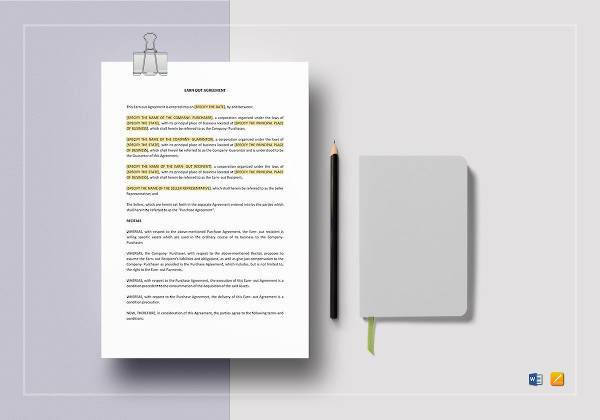
Rollover Agreement Values Shares with Adjustment Clause
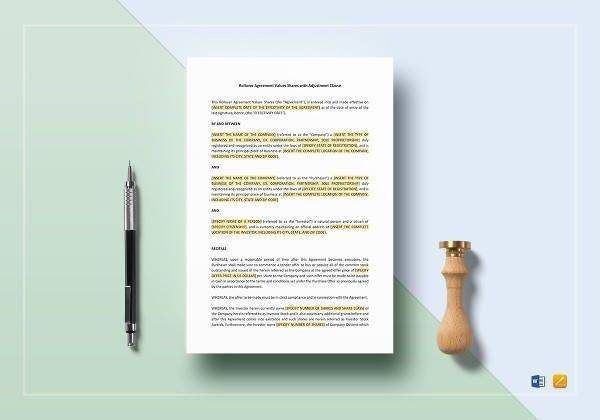
Promissory Note With Acceleration Clause
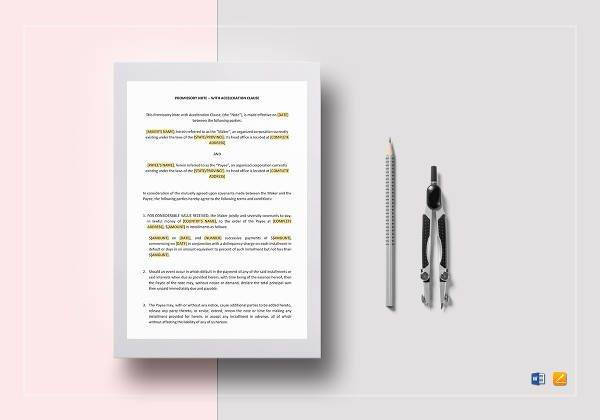
Adverb Clause Worksheet Example
Dependent Clause Worksheet Example
Dependent or Independent Clause Worksheet Example
Finding Noun Clauses Worksheet Example
The Common Types of Clauses
A clause comes in five general types: an independent clause, a subordinate clause, a relative clause, a noun clause, and an adverbial clause. To understand how they function in a sentence, let’s take a deeper look into each type:
1. Independent Clause
An independent clause, along with a subject and a predicate, conveys a complete thought and can stand alone as a sensible statement. This is also know as the main clause of a sentence due to how it functions. Although an independent clause may classify as a simple sentence, two independent clauses may be joined together using coordinating conjunctions (and, but, for, nor, or, so, and yet) or with the help of semicolons to express a detailed idea.
Examples
By adding a comma followed by a conjunction:
- Gerry is afraid of raccoons, and he ran quickly when he saw a raccoon approach the tent.
- My younger brother wanted to go to the ball game, but he had already spent his allowance.
- You can start the fire with a cigarette lighter, or you can use the charcoal from the chimney.
- Henry wasn’t interested in going to prom, nor did he have a date.
- I was late for first period, yet I still went to Starbucks to grab a cup of coffee.
- The little girl wanted to please her parents, so she did everything they told her to do.
You may also see fused sentence — examples and corrections.
By using a semicolon:
- I went to the grocery store; I forgot to buy my favorite box of cereal.
- My dad refuses to go to home early; he’s afraid we’ll get stuck in traffic.
- Chance brought the red cups; Klein brought the beer and liquor.
- Avery is going to her mom’s house in Salt Lake City; she intends to stay there all summer.
- There was a slight drizzle at the park; we managed to have an amazing time anyway.
You may also like examples of prepositional phrases.
By using a semicolon followed by a conjunctive adverb:
- The campers had been advised against wandering alone at night; however, Janine decided walking wasn’t dangerous if it was done early in the evening.
- Benjie kept slamming the lockers; therefore, he got in trouble with the hall monitor.
- I like you a lot; in fact, I think we should go out sometimes.
- Jamie is my best friend; nonetheless, I feel like she’s taking advantage of me.
- My rent payments are extremely high; on the other hand, I really enjoy living in this part of town.
You may also check out parallel sentences — structure and examples.
Other conjunctive adverbs you could use include however, moreover, as a result, consequently, and nevertheless.
2. Subordinate Clause
Unlike an independent clause, a subordinate clause cannot stand by itself. A subordinate clause, which is also referred to as a dependent clause, depends on something else in the sentence to express a complete idea. This is why subordinate clauses are often added to the main clause of a sentence using a subordinating conjunction to convey a full message. Otherwise, the clause by itself would be considered as a sentence fragment.
It’s easy to recognize a subordinate clause in a sentence because it typically starts with a subordinating conjunction. A subordinating conjunction is a word used to combine ideas together and show the relationship shared between these ideas. This may represent time, cause and effect, or contrast. Some common examples of subordinating conjunctions include the words because, although, where, and after. You might be interested in cumulative sentence examples.
Examples
- Every night before I go to bed, I eat bananas.
- The prize money goes to whoever wins the marathon.
- Where is the pitcher of lemonade that was in the refrigerator?
- The artist, whom I met at the meet and greet, was very sweet.
- While I was at the supermarket, the cat knocked over my grandmother’s vase.
The words that are italicized in these examples are the subordinate clauses, while those presented in regular text are main clause of the sentence.
You may also see run-on sentences – examples & corrections.
3. Relative Clause
A relative clause functions as an adjective in a sentence, and it is introduced by a relative pronoun (who, whom, whose, that, or which) or a relative adverb (when, where, or why). This is also known as an adjective clause which is used to further describe the noun found in the sentence. You may also like the truth behind service contract checklists.
But if there’s one thing we need to take note of, it’s that a relative clause is merely a branch of a dependent clause, therefore it does not express a complete thought.
It’s easy to identify a relative clause by looking for these three main components: (1) it contains a subject and a verb, (2) it begins with a relative pronoun or a relative adverb, (3) and it functions as an adjective that answers any questions about the noun given.
Examples
- This is the man (whom) I married.
- This is the novel (which) I am reading.
- The drink (that) I most enjoy is a mango-pineapple juice.
- The store (that) the boy robbed is on the corner.
- The corner of the street (where my family lives) is surrounded by police and investigators.
The relative pronouns in the examples above are enclosed in a parenthesis because if we omit them from the sentence, it would still express a complete thought. You may also see balanced sentences — usage and examples.
Keep in mind that relative clauses are incomplete thoughts that need to be joined to an independent clause to form a complete sentence. Sometimes these clauses are necessary to express the thought delivered in the sentence, while other times they act as mere accessories for extra detail. If it’s essential to convey a thought, then the clause is likely to contain vital information. You may also like how to write short sentences.
Due to it’s function, you do not need to include any commas in the sentence. As for a nonessential relative clause, the statement would still make sense without the presence of the said clause. Since the clause is not necessary for the meaning of the sentence, then it does require the use of commas. You may also check out periodic sentence examples.
Examples
- The children who finish their dinner can have dessert. The phrase, “who finish their dinner,” is essential to the sentence because it shows that only those who can finish their dinner can have dessert.
- Maria and her sister Janice, who is the oldest of the two, enjoy shopping together. The words, “who is the oldest of the two,” add extra information about the subjects (noun), yet the sentence would still make sense even without it.
Knowing how to identify relative clauses can help you avoid this type of sentence fragment in writing. This will also teach you how to punctuate sentences correctly and avoid comma errors for better written communication. You might be interested in what is writing used for?
4. Noun Clause
A noun clause is a type of dependent clause that functions as a noun in the sentence. A noun clause will always consist of a subject, which can also act as an object or a complement, and a verb.
Similar to a relative clause, a noun clause is usually introduced by a relative pronoun, but may also begin with a subordinating conjunction. Since it does not convey a complete thought, then the clause must be joined with the main clause to make perfect sense. You may also see formal writing examples.
Examples
- I remember what you said the other day.
- I thought what she wore was hideous.
- Now I realized what she had said.
- What you wear determines your mood for the day.
- Whatever we read increases our knowledge and understanding.
5. Adverbial Clause
Adverbial clauses are a dependent clause that act as an adverb in the sentence. The clause may modify a verb, an adjective, or another adverb by indicating when, where, why, how, how much, and under what condition was the action performed. It contains a subject and a predicate, and is often introduced by a subordinating conjunction. You may also like writing examples in pdf.
Examples of these conjunctions include because, unless, if, when, and although. These conjunctions simply indicate that whatever clause follows them is unable to stand by itself.
Examples
- When the clock strikes three, you may leave the room. (adverb of time)
- We cannot send you the goods, because we are out of stock. (adverb of reason)
- Unless you are good this year, Santa Claus will bring you nothing for Christmas. (adverb of condition)
- Once they saw the car drive in, the children immediately rushed to their bedrooms. (adverb of time)
- No matter how many times I try to stop myself, I just can’t give up cheeseburgers. (adverb of condition)
Grades 9–12 Clauses Worksheet Example
Identifying and Writing Clauses Worksheet Example
Independent Clauses Worksheet Example
Types of Sentences
A sentence may be classified into different types, depending on the number and types of clauses it contains. These are generally classified as simple, compound, complex, and compound-complex sentences. We can easily formulate these sentences by connecting clauses together using a coordinating or a subordinating conjunction. You may also see memo writing examples.
1. Simple Sentence
A simple sentence is a plain independent clause that does not contain a subordinate clause. It may also consist of compound elements such as a compound subject, verb, or object.
Examples
- Sarah and Michael are going hiking.
- The kid jumped and landed in the sandbox.
- There is a butterfly in the van with us.
- Will you help me with my chemistry homework?
- Look on top of the towel drawer for the key.
To put it simply, we can identify a simple sentence through three primary conditions: (1) it must have a subject and a verb, (2) it must convey a complete thought, (3) and it must only have one clause.
2. Compound Sentence
A compound sentence is composed of two or more independent clauses that are joined together with a coordinating conjunction, a comma, or a semicolon.
Examples
- I would have won the game, but my effort wasn’t good enough.
- Should we start the ceremony now, or should we wait for everyone to get here?
- She works three jobs to make ends meet; at least, that was her reason for being absent in every gathering.
- He took the remedial exam last Friday; he would have not passed the class otherwise.
- There was no onions in the vegetable compartment, nor did they have the money to go to the store.
3. Complex Sentence
A complex sentence is usually comprised of an independent clause along with one or more subordinate clauses. This may either come before or after the main clause.
When a subordinate clause comes before the main clause, then a comma is then placed after the subordinate clause.
Examples
- Because my soup was getting too cold, and since I still had the time to spare, I heated it in the microwave.
- Since I was running late for work, I asked my husband to drive me.
- While Katelyn sipped on her cup of coffee, she read her favorite magazine.
- Although the man was very wealthy, he was still unhappy.
- Even though the performer has participated in many competitions, he still commits a lot of mistakes.
But if the main clause comes before the subordinate clause, you do not need to add any punctuation to combine the clauses together.
Examples
- Everyone laughed when Josie got pie smashed right on top of her head.
- She returned the pair of pants after she noticed there was a tear around the waist area.
- I have to save this gift card since the clothes on stock right now aren’t very attractive.
- After the tornado hit our neighborhood there was very little left standing.
- I forgot my spare toothbrush for our vacation because I left it in my girlfriend’s house.
When used properly, complex sentences are fascinating components of the English language that can add depth to our writing. They make it easier to add in rich descriptions to our statements for a better delivery. Complex writing is one of the best ways to engage readers with compelling sentences that accurately convey a desired message. You may also see application writing examples.
4. Compound-Complex Sentences
A compound-complex sentence is just that—a combination of a compound sentence and complex sentence. Here, the sentence must contain at least two independent clauses and at least one subordinate clause for it to be classified as such.
Examples
- When I grow up, I want to be a civil engineer, and my parents are so proud of me.
- After our trip around Europe, school started back, and I was excited to see all my friends after so long.
- We can go watch a movie at the theater, but first, I have to put the dishes in the dishwasher after we finish eating.
- We won the football game, but our star player left the field in a stretcher because he broke a wrist when he scored the winning goal.
- Amanda cried when her pet dog got sick, but he got better after a two-day stay at the animal hospital.
You may also like script writing examples.
Adding Subordinate Clause Worksheet Example
Adjective Clause Practice Worksheet Example
Adjective Clause Worksheet Example
Relative Clauses Worksheet Example
Simple Adjective Clause Worksheet Example
Writing Noun Clauses Worksheet Example
Grades 6–8 Clauses Worksheet Example
Main and Subordinate Clauses Worksheet Example
Adding Dependent Clauses Worksheet Example
Using Clauses as Nouns
Using Clauses as Nouns
Noun clauses are a type of dependent clause that perform the function of a noun in a sentence. Here are some key points about using clauses as nouns:
- Functionality: Noun clauses can act as subjects, objects, complements, or the object of a preposition in a sentence. This versatility allows them to fit into various sentence structures, providing detailed information in the form of a clause.
- Introduction: They often begin with words such as that, what, who, whom, whose, whichever, whoever, how, when, where, and why. These words help to connect the clause to the rest of the sentence while introducing the noun element.
- Example as Subject: What you think does not always reflect reality.
In this sentence, “What you think” acts as the subject, performing the same function as a noun would. - Example as Object: She knows that the Earth orbits the Sun.
Here, “that the Earth orbits the Sun” is the object of the verb “knows.” - Example as Complement: The important thing is what you believe.
“What you believe” complements the subject “The important thing,” explaining more about it. - Example as Object of a Preposition: She is excited about where we are going.
“Where we are going” acts as the object of the preposition “about.” - Importance in Communication: Noun clauses add depth to communication by allowing for more complex ideas to be expressed within the framework of a simple sentence structure. They enable speakers and writers to embed additional information, opinions, or questions directly into their sentences.
- Contribution to Sentence Variety: Incorporating noun clauses into writing or speech contributes to sentence variety, making texts more engaging and dynamic.
Adverbial Clauses of Time, Place & Condition
Adverbial Clauses of Time
Adverbial clauses of time are a specific type of dependent clause that describe when something happens. They add depth and detail to the main clause by providing temporal context. Here’s a closer look at their features and usage:
- Introduction: These clauses are usually introduced by subordinating conjunctions such as when, while, before, after, as soon as, until, and since.
- Function: Adverbial clauses of time specify the timing of the action in the main clause, indicating whether the action is simultaneous with, prior to, or following another action.
- Placement: While they can be placed at the beginning or end of a sentence, their placement affects the punctuation. When starting a sentence, they are typically followed by a comma. When they come after the main clause, a comma is usually not needed.
Examples and Explanations
- When I wake up, I drink coffee.
- “When I wake up” specifies the time of drinking coffee.
- She had already left before I arrived.
- “Before I arrived” indicates the timing of her departure in relation to the speaker’s arrival.
- While we were watching the movie, the power went out.
- “While we were watching the movie” sets the scene for when the power outage occurred, showing simultaneity.
- As soon as the rain stops, we will leave.
- “As soon as the rain stops” specifies the exact condition under which they will leave, indicating immediacy.
- He has been happier since he moved to the new city.
- “Since he moved to the new city” explains the timing of his increased happiness from a specific point in the past until now.
- Until you finish your homework, you cannot play video games.
- “Until you finish your homework” sets a time condition for when the prohibition ends.
Adverbial Clauses of Place
Adverbial clauses of place provide information about the location or place where an action occurs, enriching a sentence by adding context related to “where” something happens. Here are some key points about these clauses:
- Function: They modify verbs, adjectives, and other adverbs, specifying the location of the action or state described by the main verb. Essentially, they answer the question “Where?”
- Common Conjunctions: These clauses often begin with conjunctions such as where, wherever, anywhere, and everywhere that link them to the main clause.
- Example: Where the river meets the sea, the water becomes brackish.
- In this sentence, “Where the river meets the sea” specifies the location of the action, acting as an adverbial clause of place.
- Flexibility in Placement: While they often appear at the beginning of a sentence, adverbial clauses of place can also be positioned in the middle or at the end, depending on the emphasis or rhythm the writer wishes to achieve.
- Beginning: Wherever there is light, plants will grow.
- End: Plants will grow wherever there is light.
- Purpose: By describing the location, these clauses help paint a clearer picture for the reader or listener, making descriptions more vivid and detailed.
- Example with “Wherever”: Wherever you go, I will follow.
- “Wherever you go” describes the extent of the action’s location, indicating that the action of following will occur in any location.
- Indicating Conditions of Place: Sometimes, these clauses are used not just to specify a location but also to imply conditions related to the place of the action.
- Example: Anywhere the sun touches, the soil is dry.
- This sentence implies that the condition of dry soil is directly related to the places where the sun shines.
- Example: Anywhere the sun touches, the soil is dry.
- Enhancing Descriptive Writing: Adverbial clauses of place are particularly useful in descriptive and narrative writing, where setting the scene or establishing a location is crucial.
Adverbial Clauses of Condition
Adverbial clauses of condition specify the conditions under which the actions or states described in the main clause occur. These clauses are integral to constructing sentences that express contingencies, possibilities, or hypothetical situations. Here are some key aspects:
- Key Words: Adverbial clauses of condition often begin with conjunctions such as if, unless, even if, provided that, as long as, and in case. Each of these conjunctions introduces a specific condition that affects the outcome of the main clause.
- Structure: These clauses can precede or follow the main clause. When they precede the main clause, a comma is typically used to separate them from the main clause.
- Example: If it rains tomorrow, we will cancel the picnic.
- Example: We will cancel the picnic if it rains tomorrow.
- Types of Conditions:
- Real Condition: Refers to conditions that are possible or likely to happen.
- Example: If you study hard, you will pass the exam.
- Unreal Condition: Refers to hypothetical situations or conditions that are imagined or unlikely.
- Example: If I were a bird, I would fly to tropical countries every winter.
- Real Condition: Refers to conditions that are possible or likely to happen.
- Function in Sentences: Adverbial clauses of condition play a crucial role in specifying the circumstances under which an action or event takes place. They add a layer of complexity to sentences by introducing the concept of conditionality.
- Expressing Varying Degrees of Certainty: Through the choice of conjunction and verb tense, these clauses can express different degrees of certainty and temporality regarding the condition and its outcome.
- Certain Condition: Provided that you arrive on time, we can catch the early train.
- Uncertain or Hypothetical Condition: Even if you were to leave now, you wouldn’t catch the train.
- Contribution to Meaning: By including an adverbial clause of condition, writers and speakers can create more nuanced and precise statements. They allow for the expression of doubts, conditions, and hypothetical scenarios, enriching communication
Everyday Examples of Clauses
Here are some examples of everyday expressions containing independent and subordinate clauses used in simple, compound, complex, and compound-complex sentences.
- Although my best friend invited me, I chose not to go to the dinner party.
- Since summer is fast approaching, I think I’ll cut the sleeves off my T-shirts, because I’m always hot.
- Joshua’s parents were thrilled when he got a part in the school play, although the part was small.
- We went to the restaurant right outside of town because it’s where we had our first date.
- I really didn’t like the movie, even though the casting and acting were great.
- After ten years apart, Donald still had feelings for Katherine.
- You should check the engine of your car since it’s a relatively old model, and because it’s starting to make weird noises.
- Sammy will try out for the school’s volleyball varsity team.
- Jack has been dreaming during Mrs. Doubtfire’s class.
- We will review the lesson on Friday, and the exam will be next Wednesday.
- When my package finally arrived, after a delay of more than a month, I was anxious to open it, but I decided to wait until me and my husband could share the experience together.
- My brother is a talented musician and sings in a local band.
- The professor reviewed the instructions before he passed out the exam questionnaire.
- We decided that the film was too violent, but our cousins, who enjoy watching action movies, thought that we were wrong.
- Although I like to go trekking, I haven’t had the time to go these past few months, and I haven’t found anyone who would be interested to come with me.
- Even though he prefers to eat with a spoon and a fork, he chooses to use chopsticks in Japanese restaurants; however, authentic chopsticks are quite difficult to handle.
- I usually use a pick whenever I play my guitar, or I just use my fingers whenever I feel like it.
- What our friend did was very disappointing.
- I can’t figure out why he did that.
- We will do whatever we can.
FAQs
How Do You Identify a Clause in a Sentence?
To identify a clause, look for a group of words that contains both a subject (who or what the sentence is about) and a predicate (what is being said about the subject). Clauses can stand alone as sentences if they’re independent or need additional information if they’re dependent.
What Is a Clause for Kids?
A clause is like a mini-sentence within a bigger sentence. It has a subject (like a person or thing doing something) and a verb (the action they’re doing). Some clauses can stand alone, while others need more information to make sense.
What Is a Good Example of a Clause?
A good example of a clause is: “The cat slept.” This sentence has a subject (“The cat”) and a verb (“slept”), making it a complete thought and a simple, independent clause that can stand alone as a sentence.
What Is the Easiest Way to Find a Clause?
The easiest way to find a clause is to look for parts of a sentence that have a subject and a verb. If you can find both and the group of words forms a complete thought, you’ve identified a clause.
What Clauses Are in a Simple Sentence?
A simple sentence contains only one independent clause and no dependent clauses. For example, “The dog barks.” This sentence is straightforward, with a subject (“The dog”) and a verb (“barks”), making it a simple sentence with a single clause
To sum it up, a clause is basically a combination of a subject and a verb. The two primary types of clauses are the independent or main clause, and the subordinate or dependent clause. A subordinate clause may be divided into three different categories: a noun clause, a relative clause, and an adverbial clause. You may also see tips for writing an effective essay.
Clauses are the essential building blocks to creating proper sentence structures for quality writing.
If you want to teach or learn grammar the easy way, you need to understand the basic rules and elements of combining clauses and connecting them through conjunctions. This will serve as a foundation for you to turn simple sentences into descriptive statements, otherwise known as compound, complex, and compound-complex sentences. You may also like presentation speech examples.
By understanding how clauses function in formulating sentences, putting together a sentence won’t be as complicated as you once thought!


